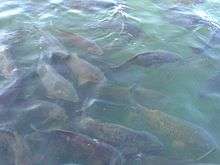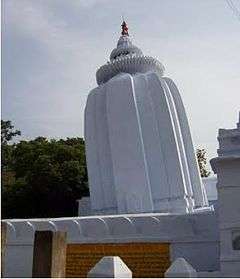Leaning Temple of Huma
| The Leaning Temple of Huma | |
|---|---|
|
Main temple in Huma | |
 The Leaning Temple of Huma Location in Odisha | |
| Name | |
| Proper name | Huma Gudi |
| Devanagari | हमा मंदिर |
| Geography | |
| Coordinates | 21°10′N 83°32′E / 21.16°N 83.54°ECoordinates: 21°10′N 83°32′E / 21.16°N 83.54°E |
| Country | India |
| State | Odisha |
| District | Sambalpur |
| Locale | Huma near Sambalpur |
| Culture | |
| Primary deity | Shiva |
| Important festivals | Shivratri |
| Architecture | |
| Architectural styles | Stone and limestone Temple |
| History and governance | |
| Date built | 1660–1788 |
The Leaning Temple of Huma in India is the only leaning temple in the world.[1][2] It is located in Huma, a village situated on the bank of the Mahanadi, 23 km south of Sambalpur in the Indian state of Orissa. The temple is dedicated to the Hindu god Shiva.
It is not known if this structure is leaning by design or from another reason. While the edifice leans, the pinnacle of the temple is perpendicular to the ground.
Architecture

Apart from the main temple the Bhairavi Devi temple is situated to the left of the main temple and Bhairo temple is situated to the right of the main temple. According to historical records Ganga Vamsi Emperor Anangabhima Deva-III built this temple. The temple was rebuilt or renovated by King Baliar Singh (1660–1690 A.D.), the fifth Chauhan king of Sambalpur. The rest of the temples were built during the rule of King Ajit Singh (1766–1788 A.D.) of Sambalpur.[3][4]


The temple is positioned on the rocky cradle just on the bank of the river Mahanadi. The basis of leaning cannot be assumed to be the technical flaws at the time of construction. It is also not easily acceptable that weak foundation might have caused leaning attitude of the temple. In fact, construction of temple is quite favourite of Chauhan Kings as well known to us from innumerable temples built during their reigns. They had already established themselves as good builders. Again, the temple is not an enormous structure. There might have been interior displacement of the rocky bed on which it stands, either due to flood current in the river Mahanadi or earthquake, thus affecting the straight posture of the original temple.
In other words, the plinth of the temple has deviated slightly from its original arrangement and as a result, the body of the temple has tilted. There is no denying the fact that this has fascinated the attention of historians, sculptors and other researchers. The surprising thing is, the main temple is tilted to one direction and other small temples are tilted to some other directions. Within the temple complex i.e. within the boundaries of temple, everything found to be in tilted condition including the boundaries and the angle of inclination is not changed since last 40/50 years as said by the villagers and priests. The reason of the tilt can be due to some geological reason, may be the earth crust is uneven in structure. The angle of inclination is yet to be measured.
Legend
The worship of Shiva is said to have been initiated by a milkman, who crossed the Mahanadi daily to a place on the bank where the underlying rock cropped out. Here he offered his dole of milk, which was immediately consumed by the rock. This miraculous circumstance led to inquiries, which ended in the construction of the present temple.[5]
Annual fair
An annual fair takes place at the foothill of the temple in March every year on Shivratri, which is a typical village fair with its unforgettable golden chasm. This fair attracts a huge crowd which includes foreign visitors. The Government of Odisha has proposed a hanging bridge to attract more tourists to the annual fair.[6] There is a special type of fish found here known as 'Kudo' fish; they are frequently fed by visitors.[3][4]
See also
References
- ↑ Sajnani, Manohar (2001). Encyclopaedia of tourism resources in India. New Delhi: Kalpaz Pub. p. 266. ISBN 8178350181.
- ↑ Kishore, author, B.R. (2008). India : a travel guide (Rev. ed.). New Delhi: Fusion Books. p. 333. ISBN 8128400673.
- 1 2 "Tourist Spots in Sambalpur District". Sambalpur.nic.in. Retrieved 2 September 2010.
- 1 2 (Panda, 1996:34–35; Pasayat, 1990:20–23; Senapati and Mahanti, 1971:51,526)
- ↑ "Article Download". Indianfolklore.org. Retrieved 2 September 2010.
- ↑ "Hanging Bridge at Leaning Temple in Huma Proposed to Woo Tourists". The New Indian Express. 23 June 2014.
